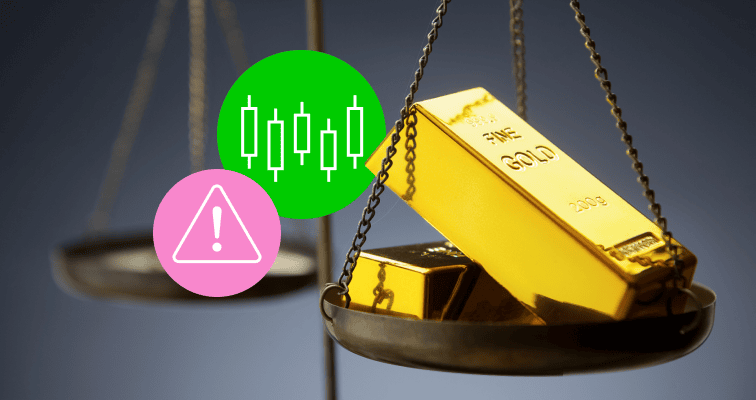The gold market has certain characteristics that are worth learning about before you start investing. Discover how to invest in gold for beginners, and answer the ultimate question: is gold a good investment?
Gold can be traded in a very similar way to other assets, including stocks, forex and crypto. Multi-asset brokerage accounts allow investors to hold a position in gold, which can potentially serve as a hedge against inflation and geopolitical risks, while enhancing portfolio diversification.
Whether you are an experienced investor looking to use gold to rebalance your portfolio, or a beginner hoping to buy gold, there are several options available when it comes to trading and investing in gold.

How to invest in gold
Gold is the most actively traded commodity in the world, accounting for around 15% of the global commodity market. It can be bought and sold using a variety of different financial instruments. But what is the best way to invest in gold?
- Gold stocks: Shares of firms involved in the extraction of gold. The share prices of these firms are, to some extent, correlated with the price of the metal.
- Gold ETFs: Fund-style products comprising a collection of gold assets.
- Gold futures: Derivative instruments traded on commodity exchanges.
- Physical gold: In the shape of bullion or jewellery.
There is not necessarily a “right” way of investing in gold. That decision will depend on your investment aims, risk tolerance, preferred strategy and investment time horizon.
Tip: Investors with a buy-and-hold approach should factor in the ongoing costs associated with the different methods of holding gold.

Is gold a good investment?
The gold market is relatively straightforward. Given that the asset does not yield dividends or coupons, passive income is not a factor that needs to be considered. The profitability or loss of a gold position is impacted solely on how the price of gold moves within the global market.
While no one can definitively predict the direction of gold prices, the mechanics of gold trading make it a relatively user-friendly endeavour. The gold market is well-established, highly liquid and usually entails relatively low trading costs.
How to trade gold
Investors employing more active strategies usually trade short- and medium-term price moves in the gold market. For example, day traders tend to hold positions in gold for very brief durations.
Contracts for Difference (CFDs) are commonly used by those who are actively trading gold. These derivative instruments mirror the price movements of an underlying asset, which could, for example, include gold futures or gold stocks.
Because a CFD is a legal agreement between a broker and a client, it can be set up to have additional functionality. CFDs can be used to sell short if you think the price of a gold-related asset will fall. They also allow you to use leverage to scale up on risk-return ratios. However, it is important to note that using leverage to trade CFDs is a high-risk proposition and is, therefore, not suited to beginners or buy-and-hold investors.
What impacts the price of gold?
The supply and demand levels of gold are influenced by a variety of factors. Gold is viewed as a safe-haven asset, traditionally witnessing heightened demand during periods of turmoil within the financial markets. Similarly, increased geopolitical risk can trigger surges in gold demand, and gold is also widely regarded as a hedge against inflation.
Gold also tends to be inversely correlated with the US dollar. A stronger USD tends to drive gold prices lower, and vice versa.
In the short-term, the supply of gold is relatively inelastic as it can take years for new gold mines to be discovered and developed.
Risks of investing in gold
The main risk associated with investing in gold is the same as with other assets — the potential for a decline in the market price. In addition, a lot of gold’s value rests on its reputation as a recognised reservoir of wealth, rather than its use as a raw material.
If sentiment were to shift and gold were to lose its status as a safe-haven asset, the price of gold could fall significantly. However, this scenario has been deliberated for centuries without materialising.
Benefits of investing in gold
Gold is set apart from many other assets due to its role as a reserve of wealth that can be tapped into in case of an emergency. Investors look to invest in gold during periods when other assets are falling in value. This is why many experienced investors recommend using gold to balance out the overall performance of a portfolio.

Final thoughts
There are very few investors who choose to invest solely in gold. It is not well-known for generating market-beating returns during periods of typical economic conditions. Instead, it is normally used as an insurance policy for times in which the prices of other positions are tumbling in value. This is why many investors choose to allocate a portion of their investment capital to gold.
Visit the eToro Academy to learn more about gold and other precious metals.
Quiz
FAQs
- What is the gold/silver ratio?
-
Analysts closely monitor the comparative values of gold and silver, as denoted by the gold/silver ratio, in an attempt to discern potential trading opportunities. While the prices of gold and silver have a strong positive correlation over the long term, the ratio of their prices can vary dramatically within shorter time frames.
- What is the difference between gold investing and gold trading?
-
The major difference between gold trading and gold investing is the lifespan of the transaction. Traders and investors can use the same strategies in the same markets, but trading involves a greater degree of commitment because traders need to continually monitor the market.
- What are the costs associated with holding physical gold positions?
-
The costs of holding physical gold positions will vary based on the method you adopt. If you hold the gold in physical form at home, storage costs are feasibly zero, although security might be a concern.
Storage fees at specialist bullion vaults are typically proportionate to the size of the holding, although this can add up for those holding gold for long periods. The challenges and costs associated with storing physical gold help to explain the presence of other financial instruments that enable exposure to the sector.
This information is for educational purposes only and should not be taken as investment advice, personal recommendation, or an offer of, or solicitation to, buy or sell any financial instruments.
This material has been prepared without regard to any particular investment objectives or financial situation and has not been prepared in accordance with the legal and regulatory requirements to promote independent research. Not all of the financial instruments and services referred to are offered by eToro and any references to past performance of a financial instrument, index, or a packaged investment product are not, and should not be taken as, a reliable indicator of future results.
eToro makes no representation and assumes no liability as to the accuracy or completeness of the content of this guide. Make sure you understand the risks involved in trading before committing any capital. Never risk more than you are prepared to lose.


